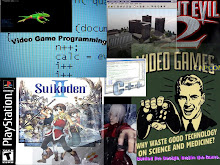Subscribe to:
Post Comments (Atom)
skip to main |
skip to sidebar


My Graduation Project for 2010
Collage

Useful Links
Key Terms
- 1. Computer programming (often shortened to programming or coding) is the process of writing, testing, debugging/troubleshooting, and maintaining the source code of computer programs.
- 2. C++ is a general-purpose programming language. It is regarded as a middle-level language, as it comprises a combination of both high-level and low-level language features. It is a statically typed, free-form, multi-paradigm, compiled language where compilation creates machine code for the target machine hardware, supports procedural programming, data abstraction, object-oriented programming, and generic programming.
- 3. Game programming, a subset of game development, is the programming of computer, console or arcade games. Though often engaged in by professional game programmers, many novices may program games as a hobby. Some software engineering students program games as exercises for learning a programming language or operating system.
- 4. C# (pronounced C Sharp) is an object-oriented programming language developed by Microsoft as part of the .NET initiative and later approved as a standard by ECMA (ECMA-334) and ISO (ISO/IEC 23270)
- Beta- A beta version of a game is complete except for last minute tweaks, tuning and bug fixes.
- DirectX- DirectX is an SDK by Microsoft that is used to quickly access hardware.
- Engine- An engine is the code that makes a game run. An engine can be used for multiple games by using different art and data sets. The Quake 3 engine is a great example that was not only used by the game Quake 3 Arena but also by Star Trek Elite Forces and Alice. A good engine can often be licensed to other developers.
- Fox- To cancel a game due to legal issues relating to possible infringement of intellectual property by the game developers. The term is derived from 20th Century Fox Corporation causing a game mod to be cancelled.
- Game Artificial Intelligence- Game artificial intelligence or AI is logic used to determine a computer players decisions.
- Gameplay- The important and hopefully entertaining interactions between a player and the game world.
- Java- An interpreted object-oriented programming language that is based off C/C++ syntax. It's generally slower then compiled languages but the code can be run on any computer with a Java interpreter.
- MIP-Mapping- A MIP-Map is a file with multiple images of the same object. These images are different sizes. The different sizes are used to reduce the amount of memory used if the object was far away by using the smallest image of the object that would be as small or larger then how the image should look in the game.
- OpenGL- OpenGL is a graphics SDK for PCs and Macs used to develop 3D games like Quake.
- Overlay- An image can be overlaid over other images. An overlay image will not change often and will be placed over the game view. An example of an overlay is a resource count and health information that is displayed at the top, bottom, or side of the screen over the game world.
- Software Development Kit- A software development kit or SDK is a tool that programmers use to develop games without having to write hardware or hardware emulation code from scratch. Instead they can use function calls to the SDK library of pre-defined hardware and hardware emulation code. DirectX and OpenGL are both popular SDKs that game programmers use.
- Web Game- A game played on a web page. These are usually made in HTML, Java, JavaScript, Flash, Shockwave, or Visual BASIC.
Blog Archive
About Me

- James Phillips
- I am a simple person who likes simple things. I'm mostly lazy and just want some time to pass by...
No comments:
Post a Comment